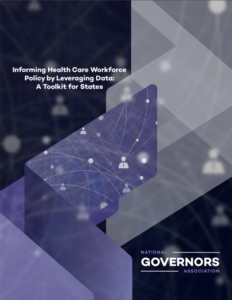By collecting standardized information on licensed health care professionals, states can streamline health care workforce data collection and analysis to address key policy questions and improve health care access and delivery.
Executive Summary
Ensuring an adequately trained and well-distributed health workforce is critical to maintaining the health and well-being of the population. Imbalances in supply and distribution make it challenging for already overburdened providers to meet the needs of their communities and threaten states’ ability to effectively prepare a workforce response in times of public health crises. State policy makers need accurate health care workforce data to assess the supply, demand, and distribution of health care providers and to plan for the future. Accurate health workforce data will help states achieve an appropriate balance of clinicians in the right settings and geographic locations to meet demand. It can also help states assess existing recruitment and retention policies and restructure incentives to address gaps. By collecting standardized information on licensed health care professionals, states can streamline health care workforce data collection and analysis to address key policy questions and improve health care access and delivery.
This toolkit 1) describes how health care workforce data can be used to address questions regarding access to care, 2) provides a series of considerations for states to improve their health care workforce data collection, and 3) presents examples of states that have leveraged data effectively to inform policy.
Introduction
The health care workforce is critical to maintaining the health and well-being of the population within a given state. However, many states lack information necessary to accurately assess the existing supply, demand, and distribution of health care providers. Without data, states may have a general awareness of workforce shortages and geographic imbalances, generally represented by higher concentrations of health care providers in and surrounding certain metropolitan areas and lower concentrations in rural and low-income urban areas, but they lack ability to quantify the issues. With the right data, states can make decisions based on facts rather than anecdotes, leveling the playing field across interested parties.
Some researchers predict national shortages of certain health care providers that will grow worse over time. In addition, health care workforce imbalances threaten states’ ability to effectively respond in times of public health crises. As states transform their health care systems to enhance the quality and slow the growth of health care costs, new delivery models require investment in different types of providers and new technologies to provide care in diverse settings. Imbalances in supply and distribution can make it challenging for already overburdened providers to serve their communities, making transformation efforts potentially seem out of reach and further exacerbating access and quality disparities in rural and other underserved areas.
With more robust data states can take a more holistic approach with consideration of state specific payment, delivery, and licensure policies to address the supply and distribution of providers by specialty, setting, and location to ensure the right providers are in communities where they are most needed.
Normal health workforce challenges have been exacerbated by the COVID-19 pandemic. As cases of COVID-19 have risen and demands on the workforce have increased, states have established significant flexibilities through executive orders, legislation, regulations, and guidance to increase the size and capacity of the workforce. Facing current significant budget shortfalls, states must evaluate their programs and identify areas of greatest need to inform policy and programming, including how telehealth policies affect the health workforce.
Collecting and analyzing health care workforce data helps states identify shortages and maldistribution, leverage targeted workforce development solutions, prepare responses to public health emergencies, and plan for the future by analyzing trends and anticipating changes. As states incentivize new payment and delivery models and scope of practice policies evolve, it is important to continuously look at health workforce trends in the context of such changes. By collecting standardized information on licensed health care professionals, states can identify areas of need and determine if current recruitment and retention strategies are working.














